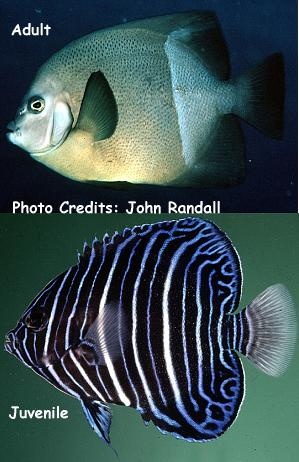
By Bob Goemans

Not Reef Tank Suitable
Likely Fish-Only Tank Suitable
Range: Western Indian Ocean: Delagoa Bay, Mozambique to Knysna, South Africa
Size: 18 inches (45 cm)
Natural Environment: Inhabits inshore waters at depths of 10 to 100 feet (3 – 30 m) where adults congregate in mid to surface waters with juveniles often seen in tidepools. Feeds on sponges, tunicates, coral polyps, worms, crabs, algae and zooplankton.
General Husbandry: The juvenile is quite pretty, and in fact, is quite similar looking to other juvenile species in this genus as its completely black with wavy blue and white vertical lines. As for the adult, it’s quite drab with the body front two-thirds a tannish brown and the back third a pale bluish, a whitish face and a small hump on the head.
Because of its drab adult colors and its collection areas are infrequently visited by collectors, this species is rarely seen in the trade. Nevertheless, should it ever be acquired, keep in mind this is the largest in this genus and also known to be extremely shy, therefore it should be introduced into a well-established fish-only aquarium with lots of live rock and cave areas. Adults or juveniles should be offered numerous daily feedings so as to quickly acclimate it to its surroundings. Like many others in this genus, their captive diet should consist of a wide variety of frozen foods including fortified brine shrimp, mysis, and especially those containing sponge matter/angelfish food preparations and continued to be offered at least several times daily after its acclimated to its surroundings. Furthermore, flake foods, and especially those containing Spirulina and/or Nori should be also offered, along with fresh broccoli and macroalgae, as ‘greens’ make up a portion of this species diet, especially the juveniles. Its preferable it is the last angelfish to be added to the aquarium.
Taxonomy:
Order: Perciformes
Suborder: Percoidei
Family: Pomacanthidae
Genus: Pomacanthus
FYI: Keeping more than one genus of angelfishes in the same aquarium is possible, yet depends upon several aspects. The following suggested circumstances are just that, possibilities that when heeded and adjusted to actual aquarium conditions ‘may’ make multiple angelfish collections feasible.
Aquarium size – the larger the better.
Species from the same genus should not be in the same aquarium.
The smallest and most docile genus species should be the first introduced with the largest and most malicious the last to be added.
Do not place similar coloration species in the same aquarium.
Those already in the aquarium should be well fed before adding a newcomer.
Have sufficient hiding places/rocky caves.
Do not overfeed meaty foods, especially juveniles, as it may lead to a fatty deposit around the liver that could stop production of vitamin A. This could cause blindness, often referred to as nutritional blindness.
Keep in mind all angels have cheekspines at the edge of their gill cover; therefore use caution when handling and also avoid using a net to capture it, as it may become stuck or tangled in the net and become damaged when removed.
Experience Level: Intermediate
Temperament: Semi-aggressive
Diet: Omnivore
Acclimation Time: 30 minutes+
Aquarium Environment: Fish-only
Reef Safe: No - will nip clam mantles, large and small polyped stony (LPS/SPS) corals, and also some soft corals, tubeworms and eat crabs and snails.
Minimum Tank Size: 250 gallons
Temperature Range: 66 - 79°F (19 – 26°C)
Specific Gravity: 1.020 - 1.026
pH: 8.0 - 8.5
